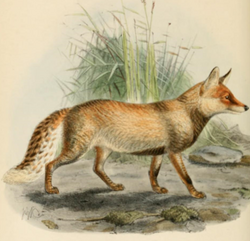Biology:Hill fox
| Hill fox | |
|---|---|

| |
| A depiction of an individual done by John Gerrard Keulemans in 1890 | |
| Scientific classification | |
| Domain: | Eukaryota |
| Kingdom: | Animalia |
| Phylum: | Chordata |
| Class: | Mammalia |
| Order: | Carnivora |
| Family: | Canidae |
| Genus: | Vulpes |
| Species: | |
| Subspecies: | V. v. montana
|
| Trinomial name | |
| Vulpes vulpes montana Pearson, 1836
| |
| Synonyms | |
| |
The hill fox[1] (Vulpes vulpes montana),[2] also known as the hill red fox,[1] or the Himalayan red fox,[3] is a subspecies of the red fox that is native to parts of the Himalayan Mountain Range and Karakoram Mountain Range. It has two noticeable populations: one being in northeastern India, far southern Nepal, and far northern Bangladesh. The other is in portions of far northwestern India, and northeastern Pakistan . Populations may be present in way far southwestern China, and in other areas of the Himalayas.[4] Its natural range is made up of rocky terrain, low grasslands, and tundra within a temperate climate.[5] The hill fox is differentiated from the nominate subspecies by having a smaller sized body, smaller skull, teeth, and by having rough or coarse hair. Its feet hair are mixed with softer, woolly hair.[6] It is occasionally known to build dens near human-urbanized areas.[7] Additionally, researchers found these foxes in Shigar valley, Karakorum Range, Pakistan and studied their living habits and their locations of dens. Their studies showed that in their resting state 83.33% of the foxes have a den in a grass/bare habitat.” [7] Many Vulpes Vulpes Montanas are high altitude animals and they have many mechanism adaptations due to their environment. Studies have shown that “many high-altitude animals reduced O2 demand by suppressing total metabolism to compensate for a reduced cellular O2 supply as a response to hypoxia.” [8] There are many studies that take account of their genetic information to understand their evolution and adaptation in high-altitude habitats. One study used, “blood samples obtained from a wild female red fox captured from Lhasa in Tibet, China. Qinghai--Tibet Plateau is the highest plateau in the world with an average elevation above 3500 m.” [9] In this study they analyzed the sequences of their genes and found a gene that corresponds to their ability to adapt in their environments.
References
- ↑ 1.0 1.1 "Hill Fox - Vulpes vulpes montana" (in en). https://observation.org/species/719677/.
- ↑ "Vulpes vulpes montana (Pearson 1836) - Encyclopedia of Life". https://eol.org/pages/1270437.
- ↑ "Himalayan Red Fox (Subspecies Vulpes vulpes montana)" (in en-GB). https://uk.inaturalist.org/taxa/1308322-Vulpes-vulpes-montana.
- ↑ "Vulpes vulpes montana (Pearson, 1836)" (in en). https://www.gbif.org/species/6164301.
- ↑ ENVPK (2021-05-04). "Ecosystem Zones and Climatic Biomes of Pakistan" (in en-US). https://www.envpk.com/ecosystem-zones-and-climatic-biomes-of-pakistan/.
- ↑ Pocock, Reginald Innes (1941). "The Fauna of British India, Including Ceylon and Burma: Mammalia Volume 2, Carnivora: Aeluroidea, Arctoidea". The Fauna of British India, Including Ceylon and Burma 2. https://archive.org/details/PocockMammalia2.
- ↑ 7.0 7.1 Zaman, Muhammad; Tolhurst, Bryony; Zhu, Mengyan; Jiang, Guangshun (May 22, 2020). "Den-site selection at multiple scales by the red fox (Vulpes vulpes subsp. montana) in a patchy human-dominated landscape". Global Ecology and Conservation 23: 3. doi:10.1016/j.gecco.2020.e01136. https://cris.brighton.ac.uk/ws/files/13675951/Zaman_et_al_2020_proof.pdf.
- ↑ T, Lyu; X, Yang; H, Zhang (2022). "Comparative transcriptomics of high-altitude Vulpes and their low-altitude relatives". Frontiers in Ecology and Evolution 10. doi:10.3389/fevo.2022.999411.
- ↑ J, Zhang; H, Zhang; C, Zhao; L, Chen; W, Sha; G, Liu (2015). "The complete mitochondrial genome sequence of the Tibetan red fox (Vulpes vulpes montana).". Mitochondrial DNA 26 (5): 739–741. doi:10.3109/19401736.2013.845766. PMID 24456141.
Wikidata ☰ Q9095106 entry
 |

